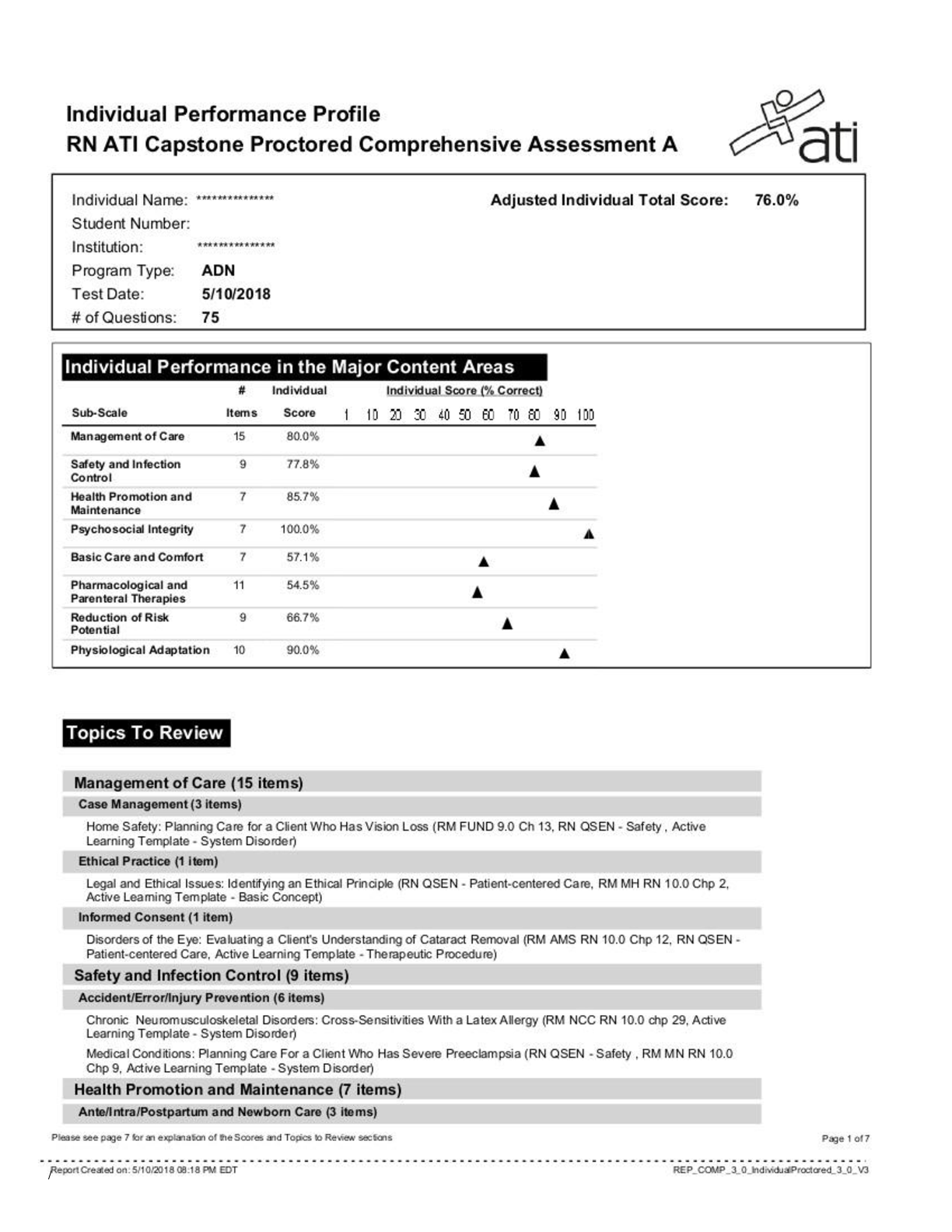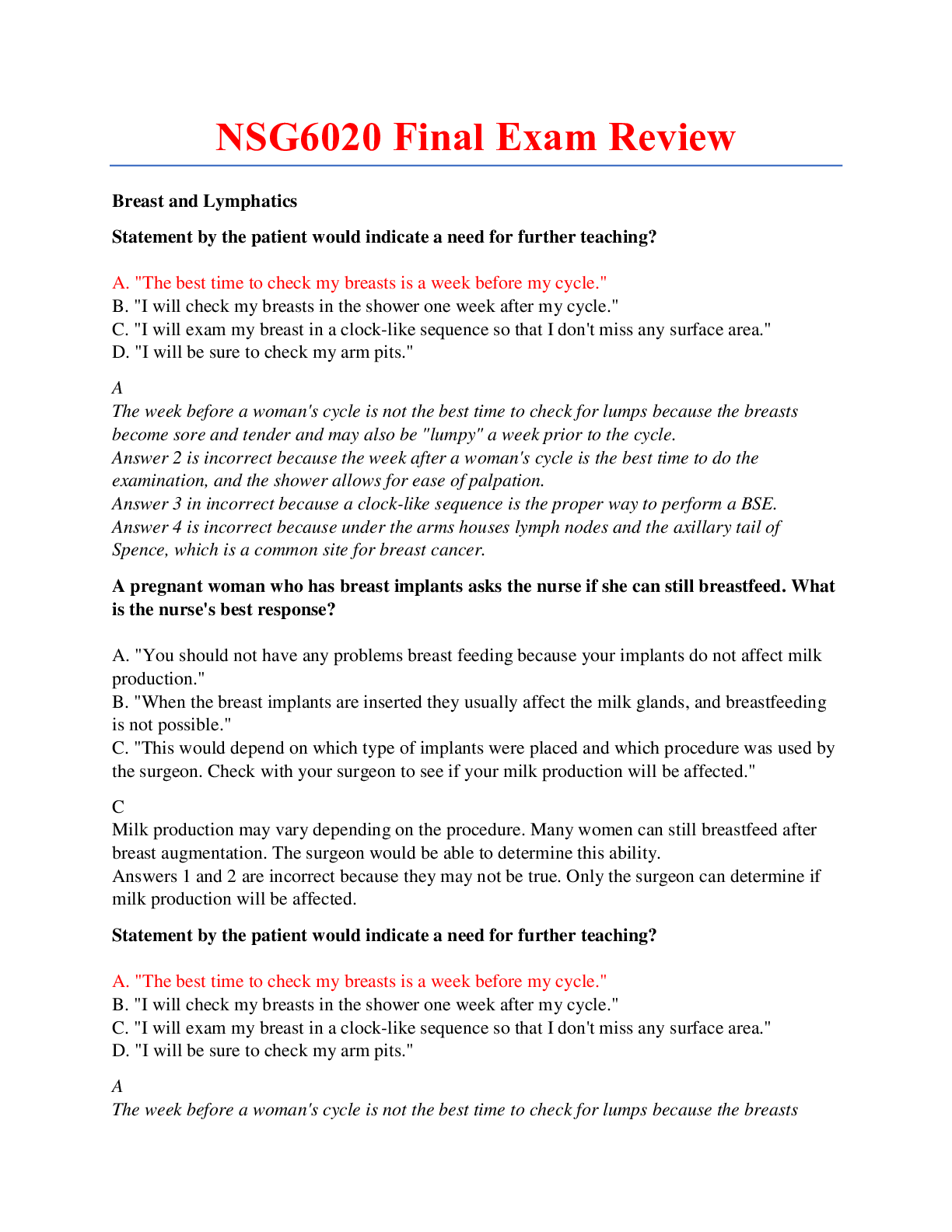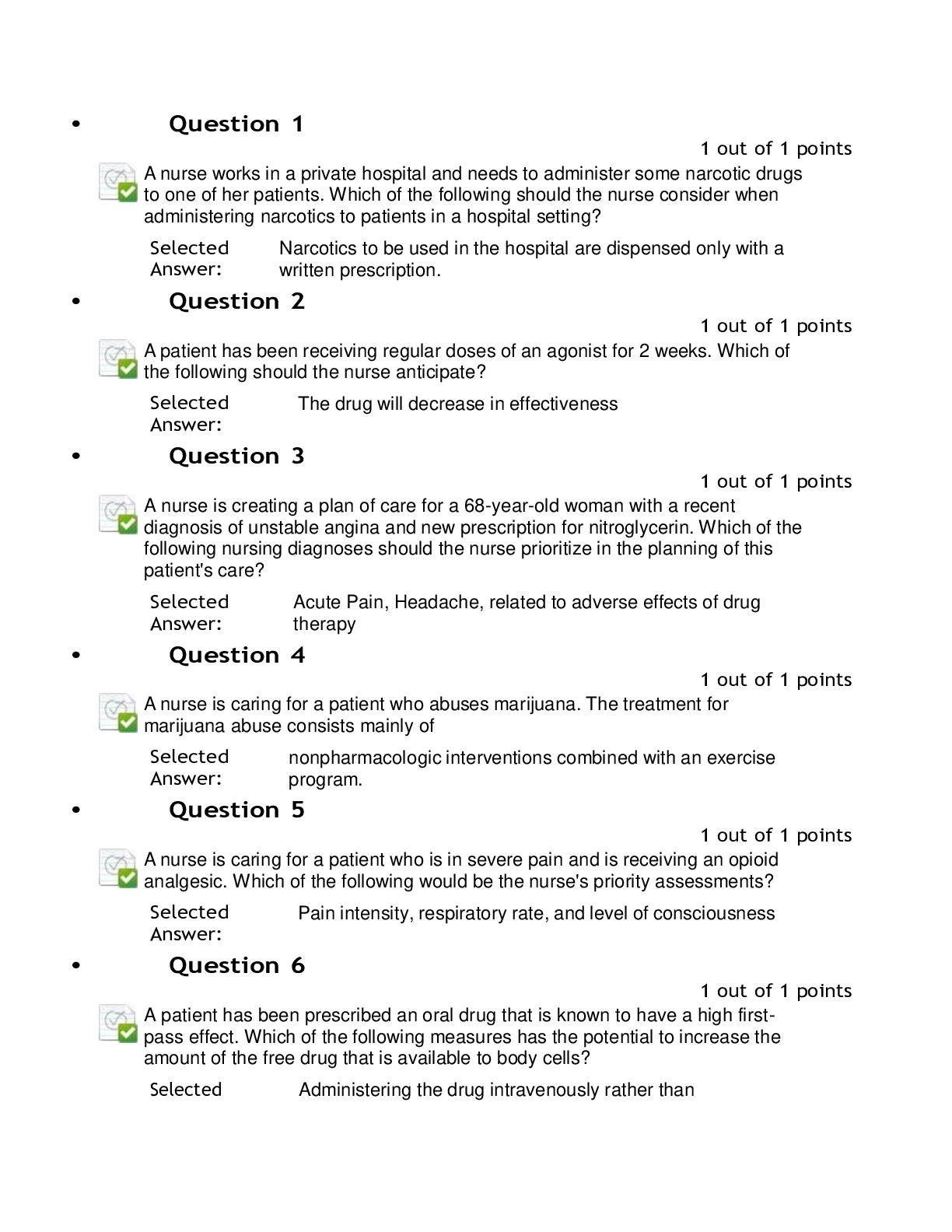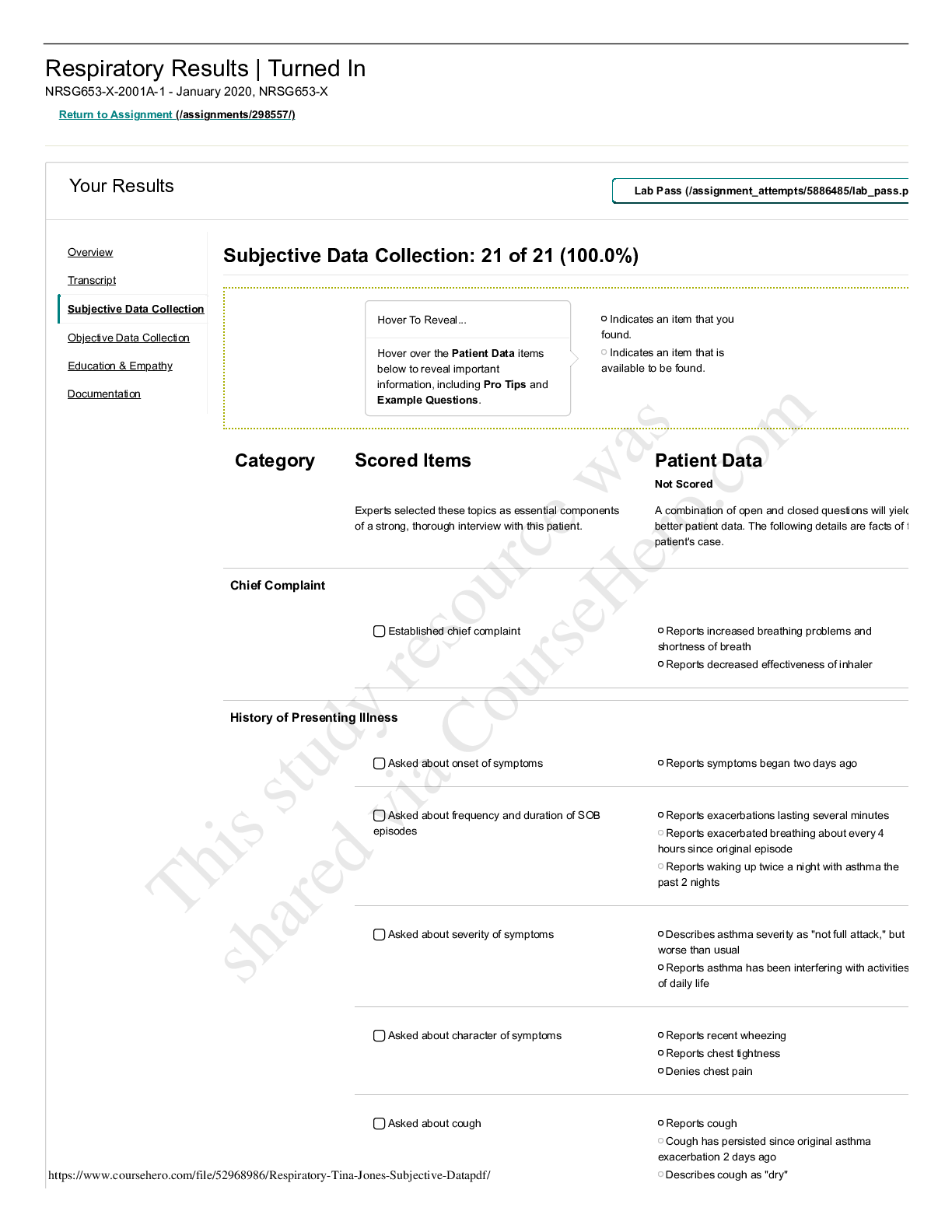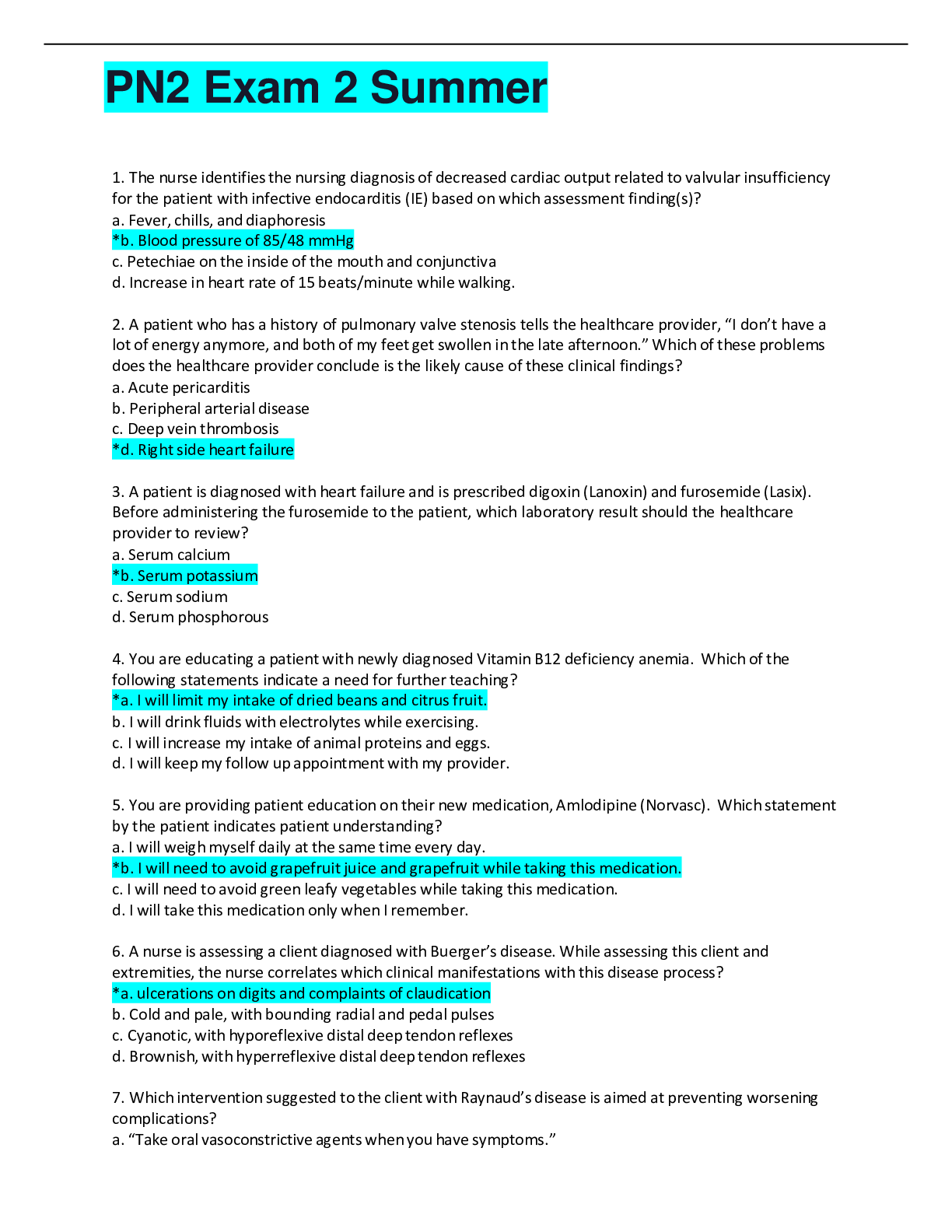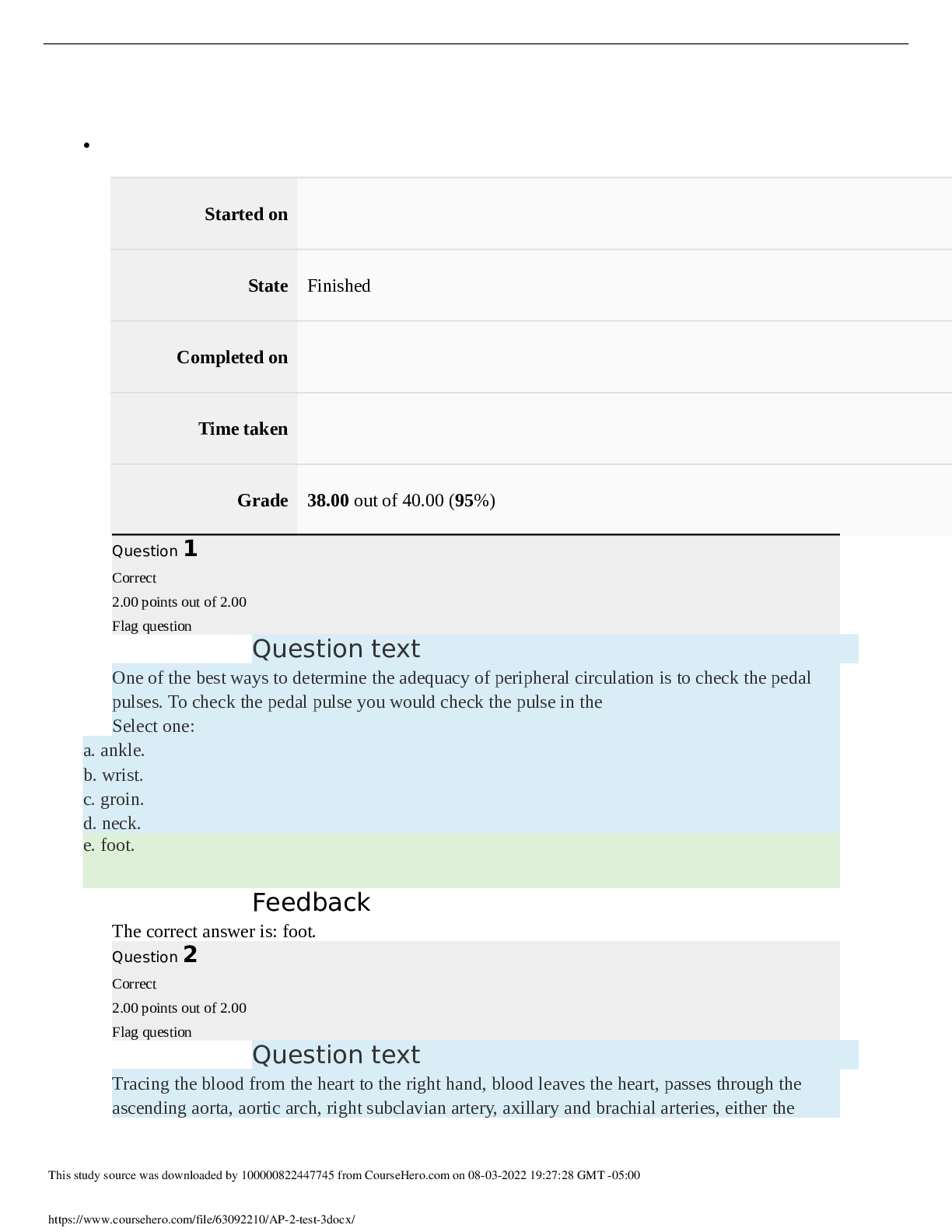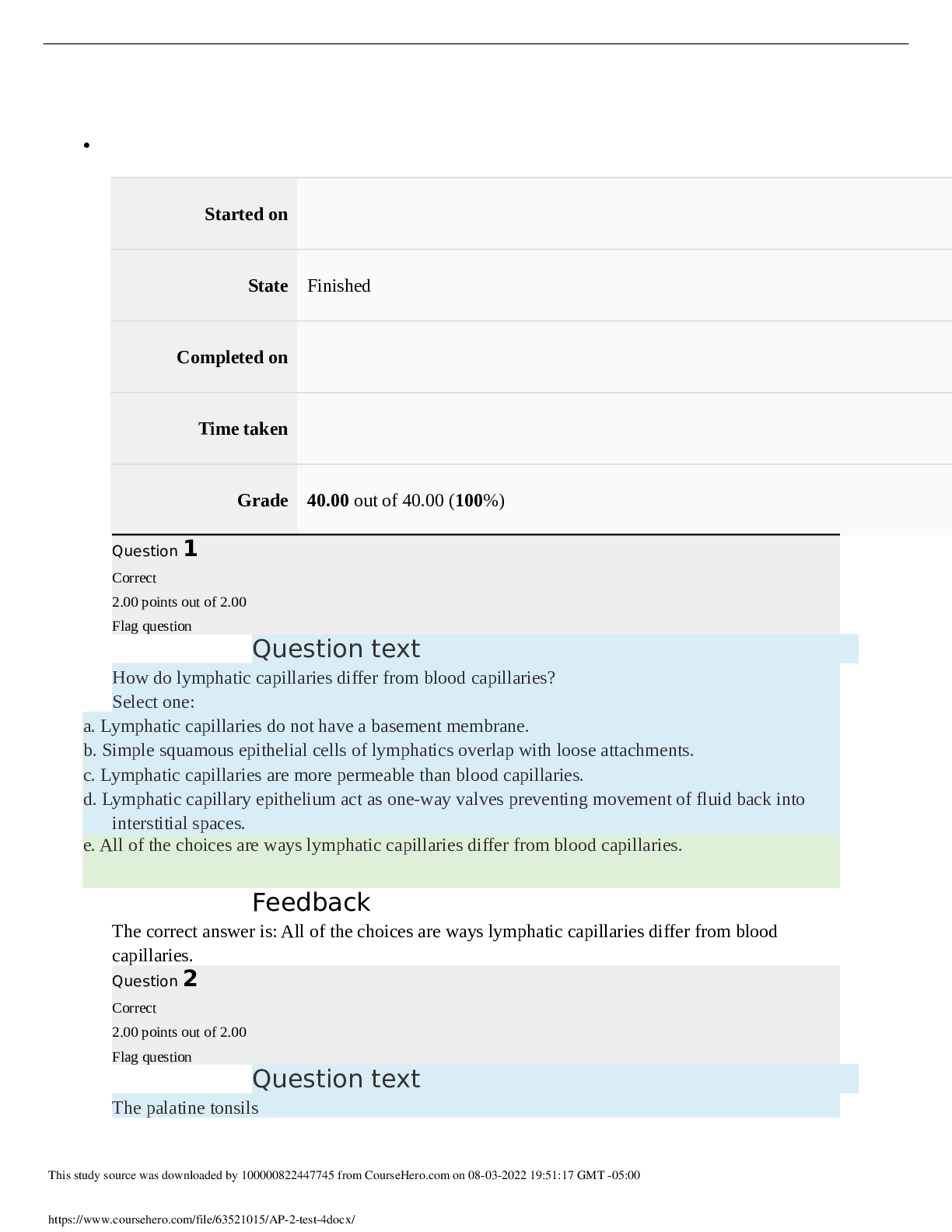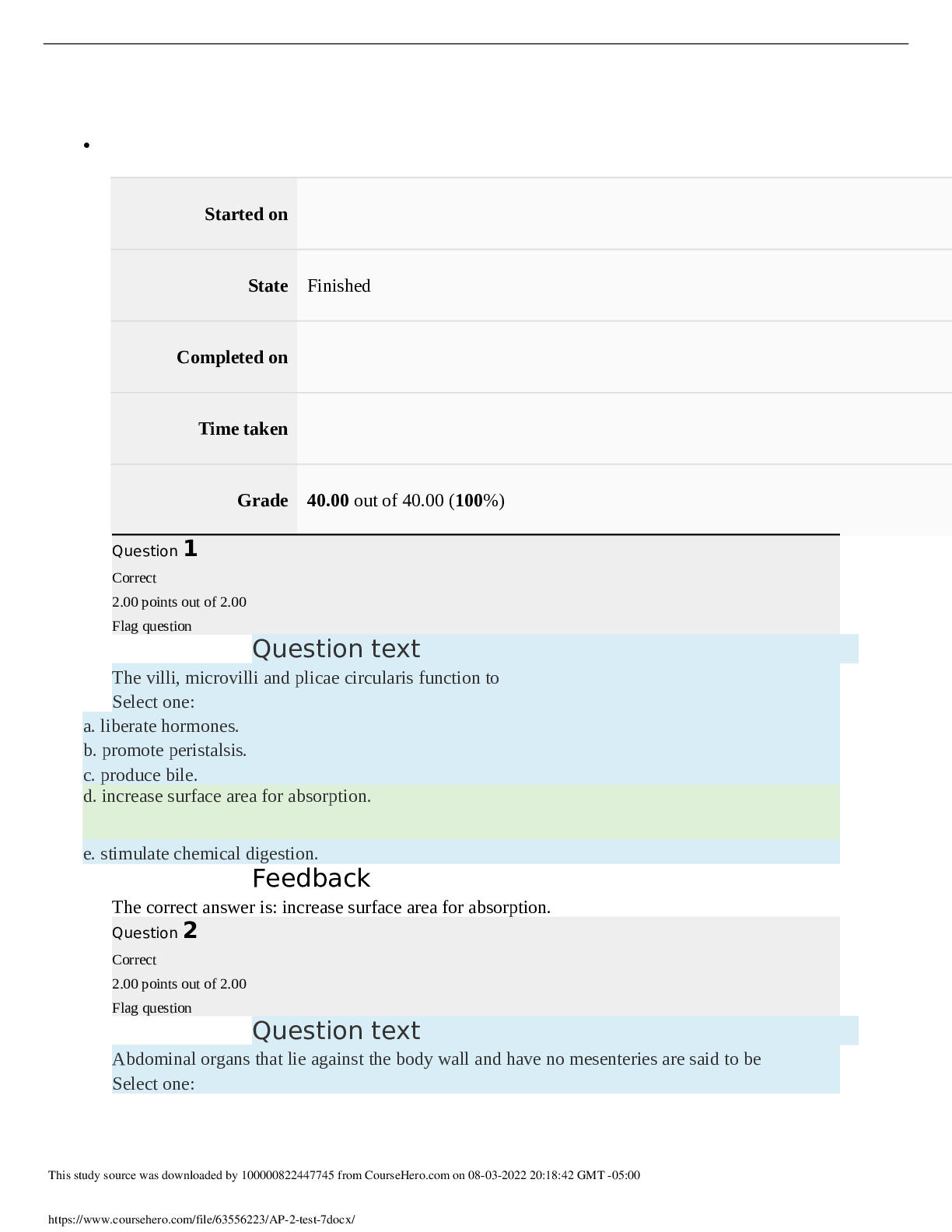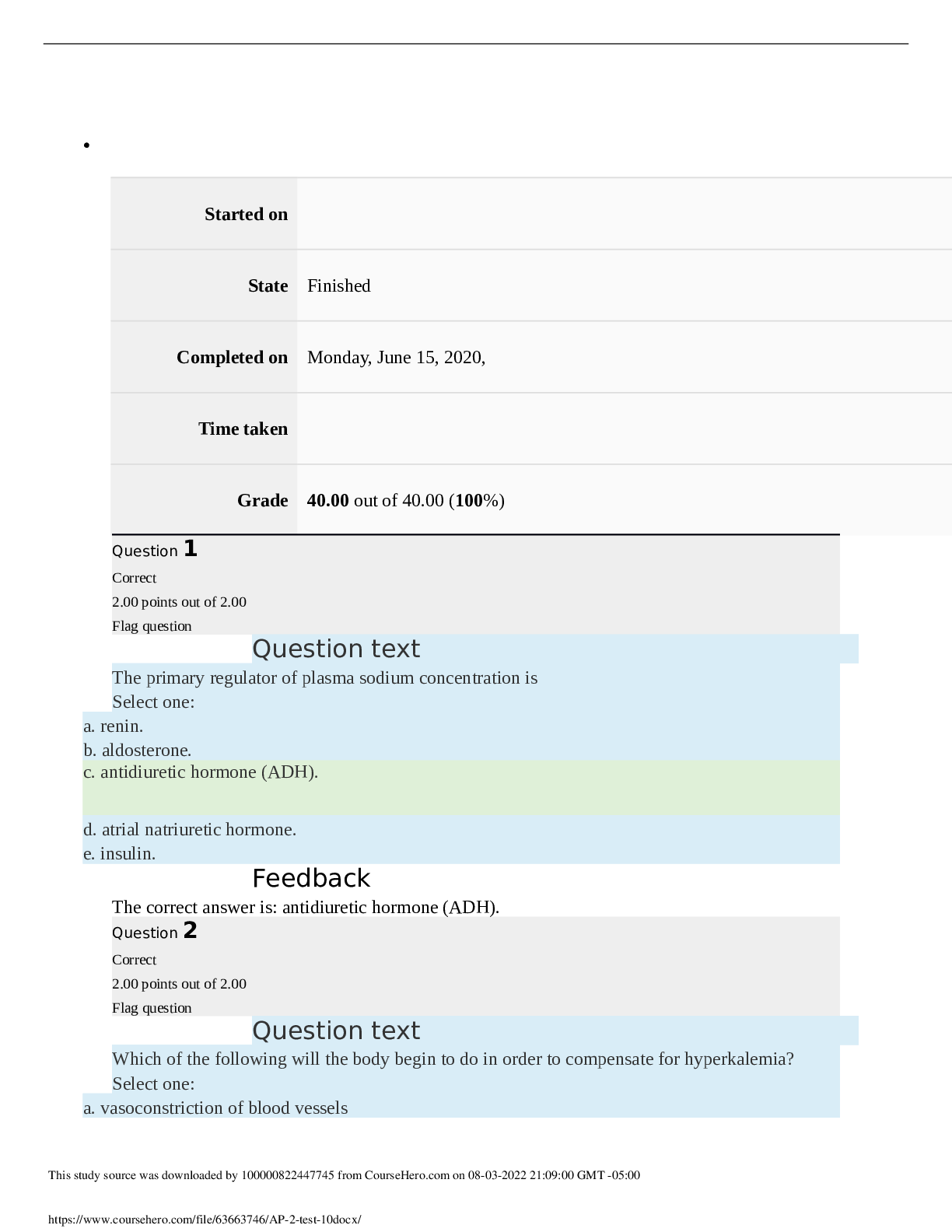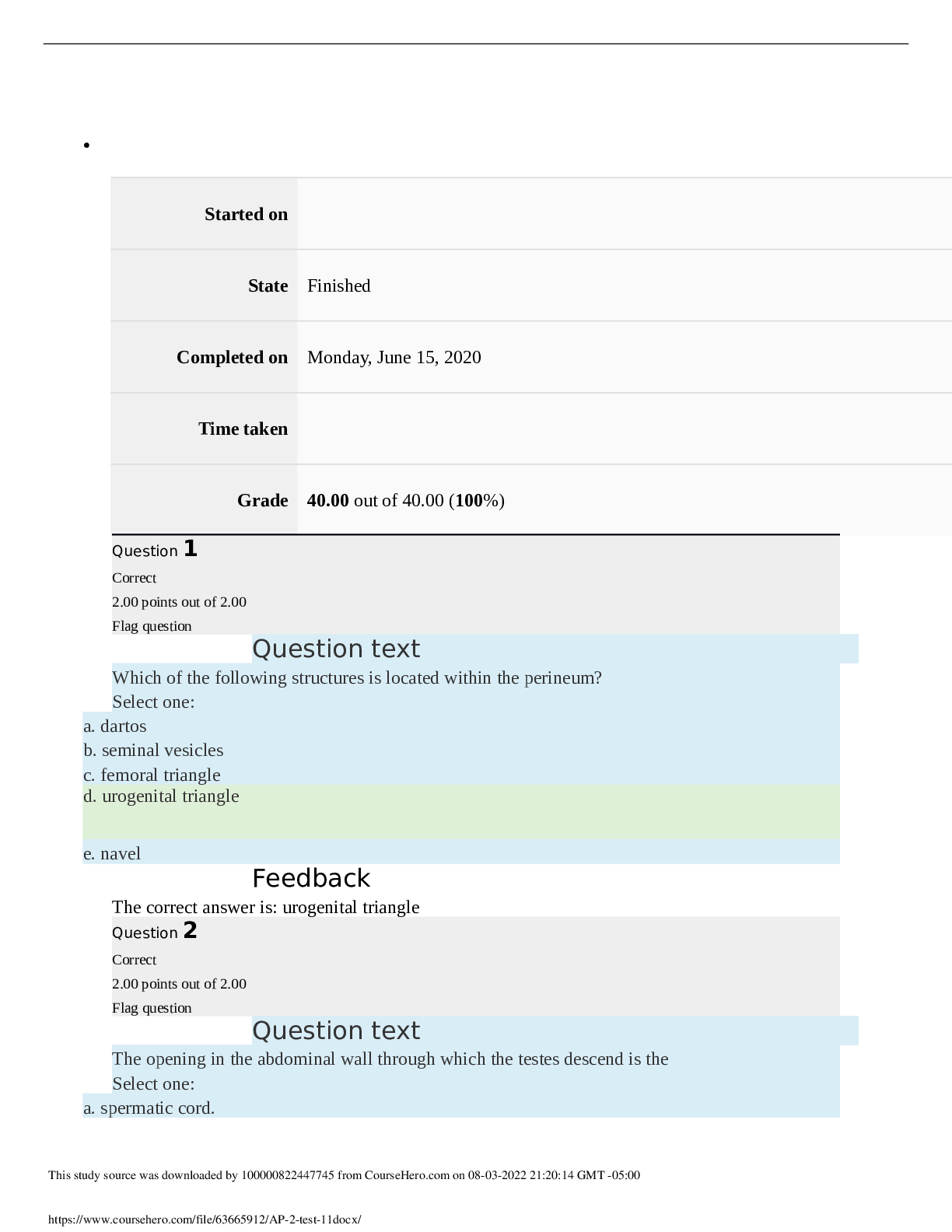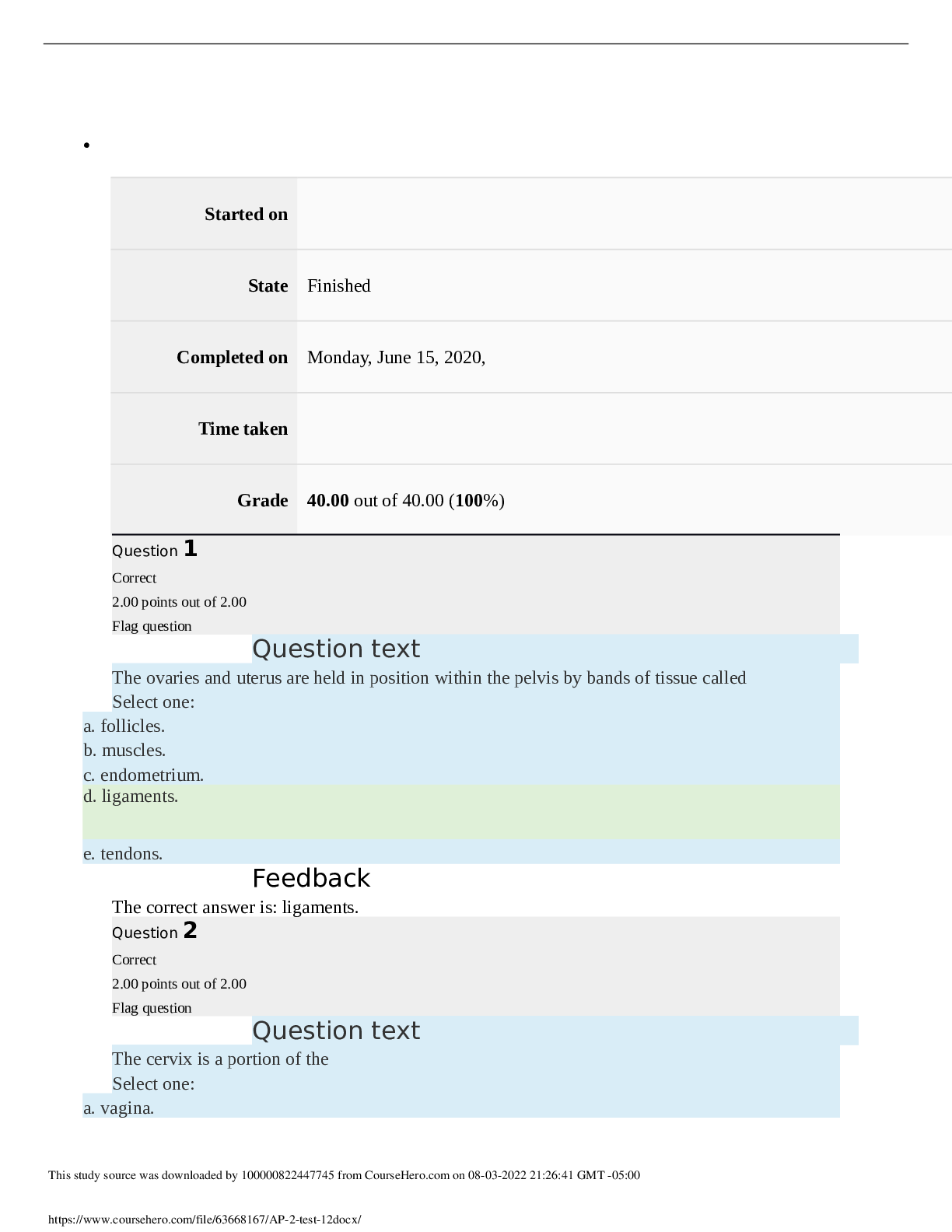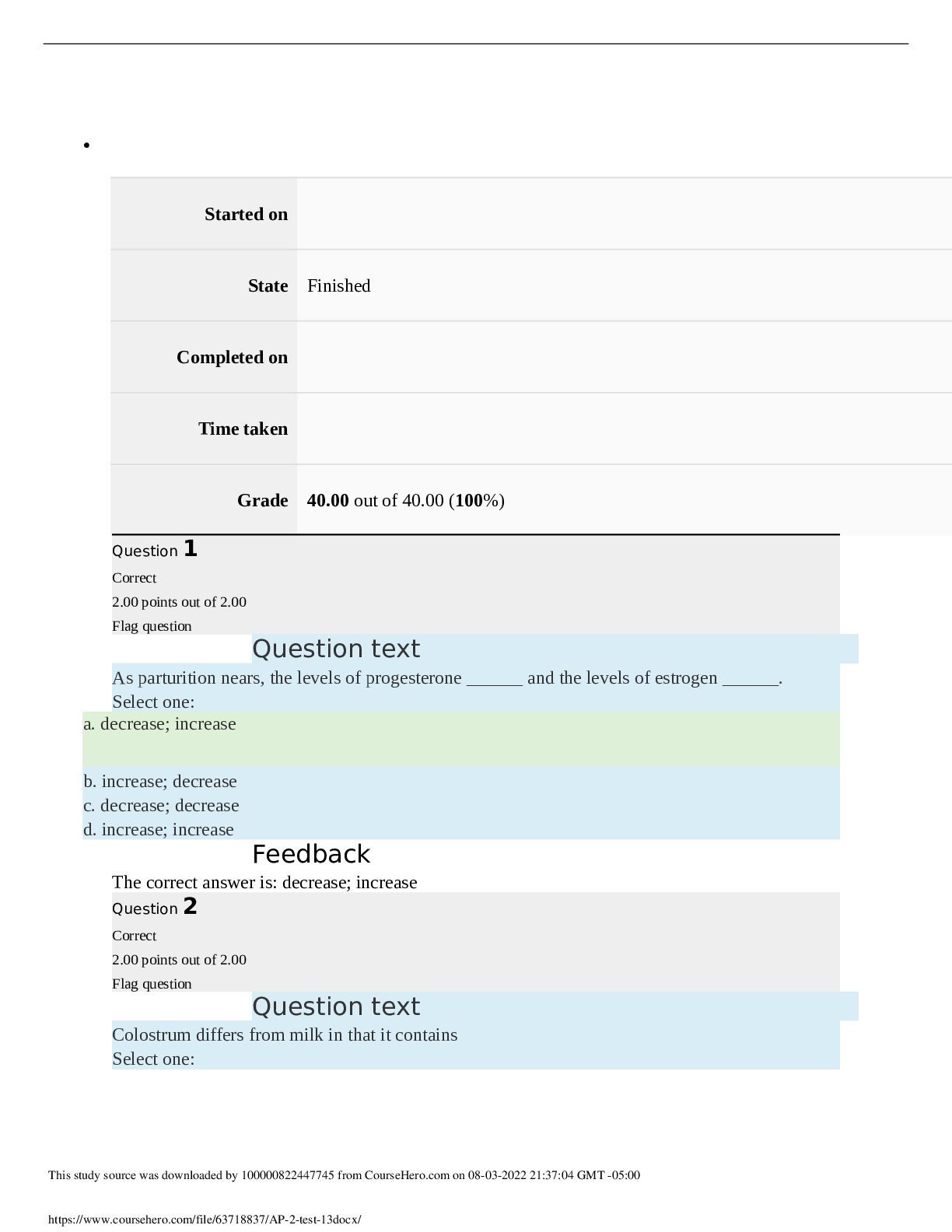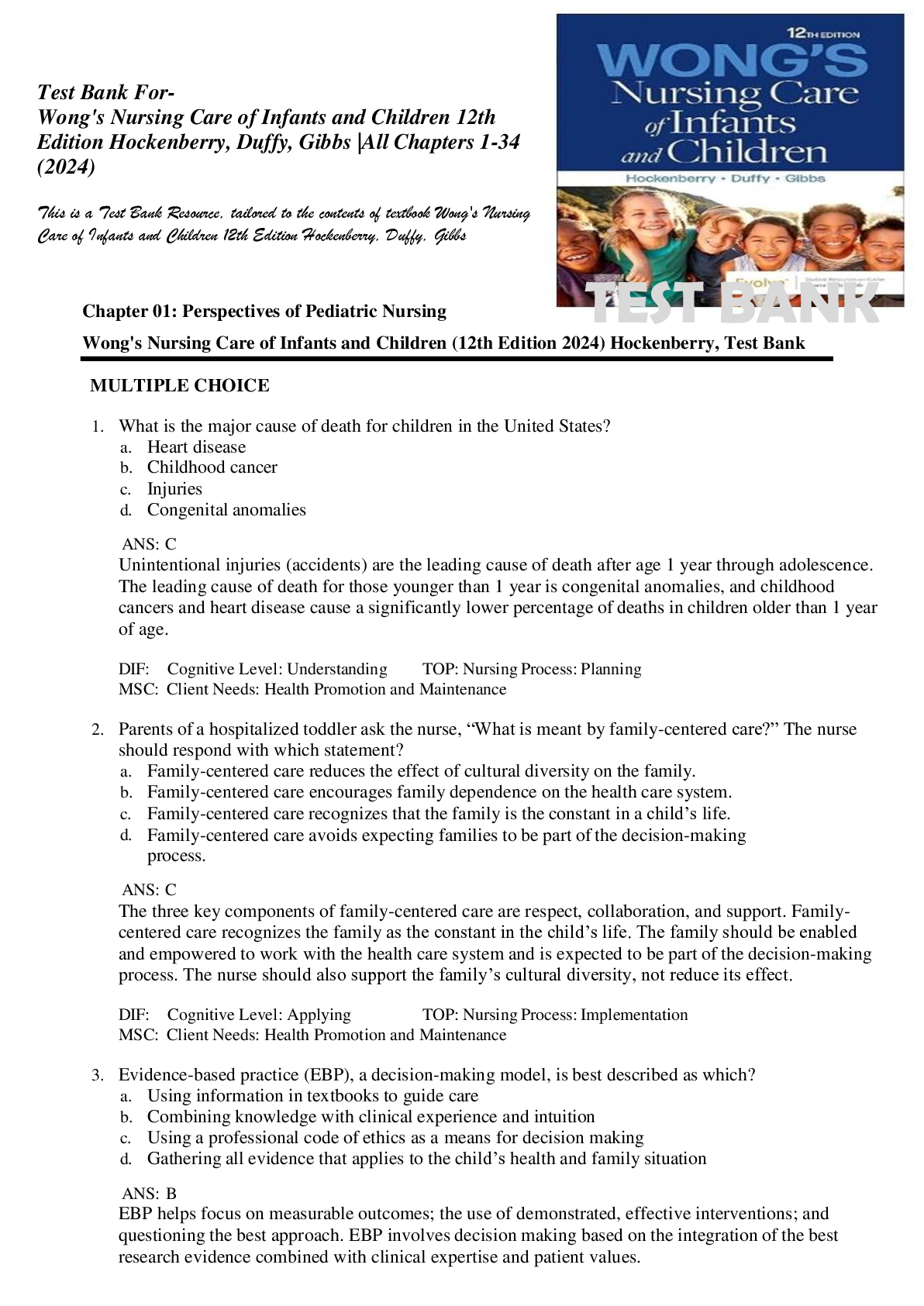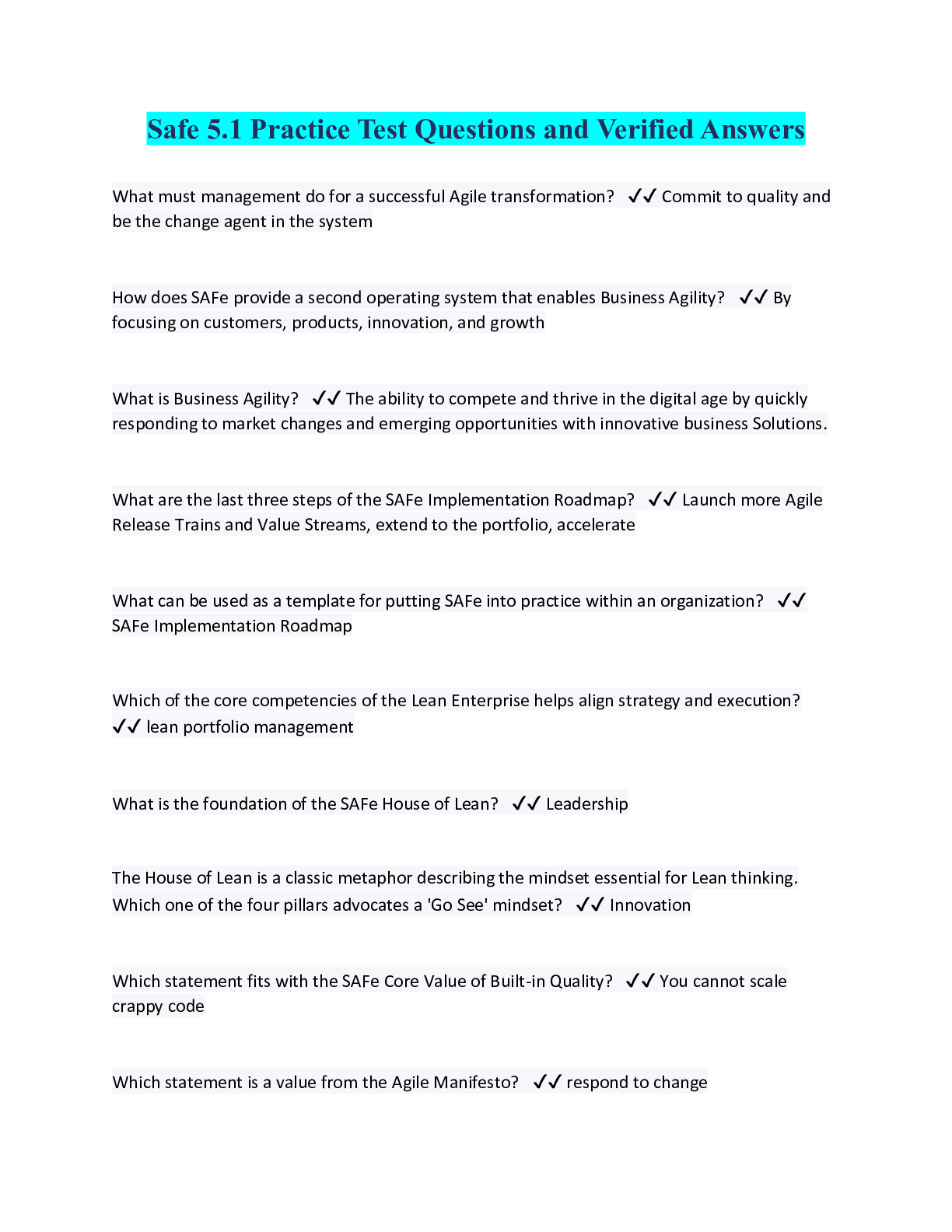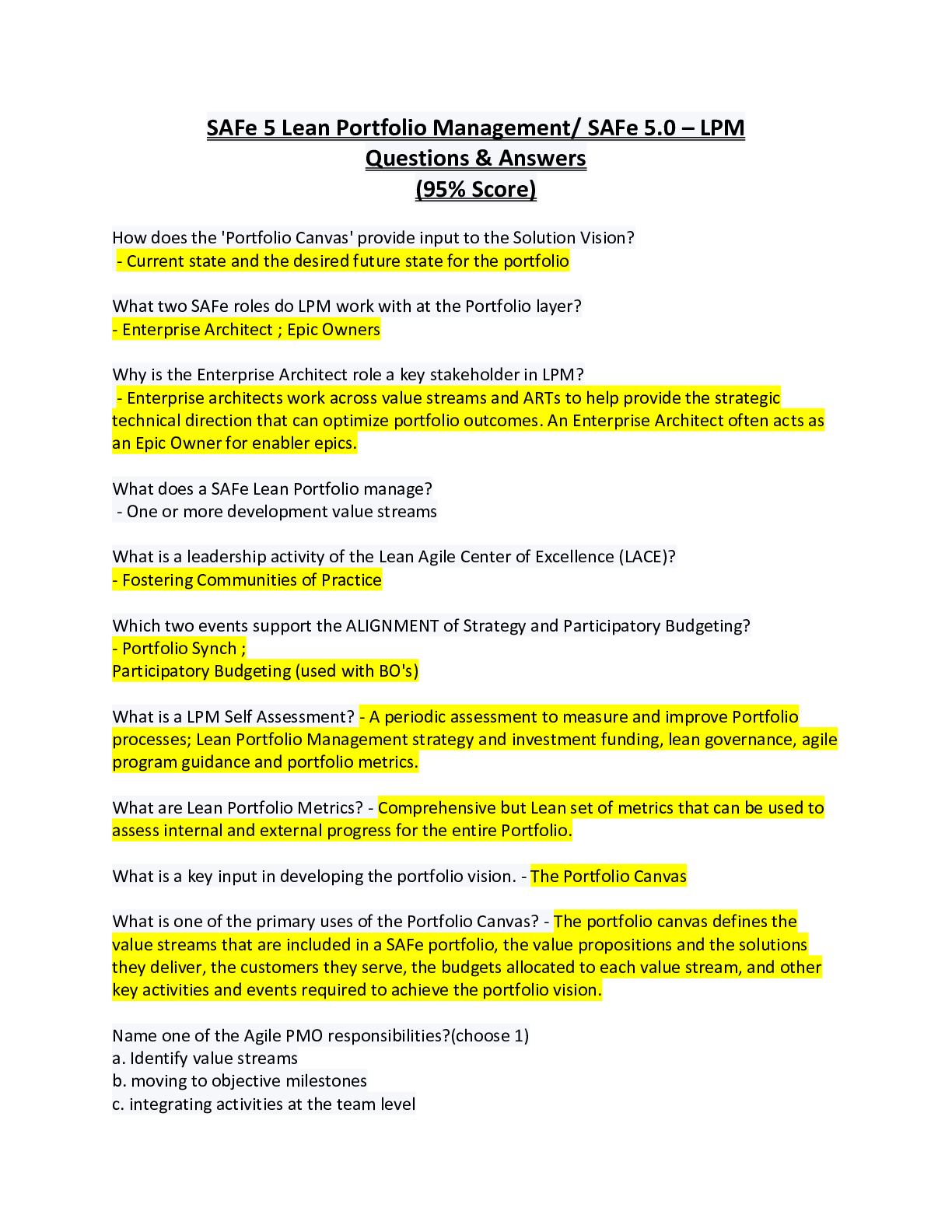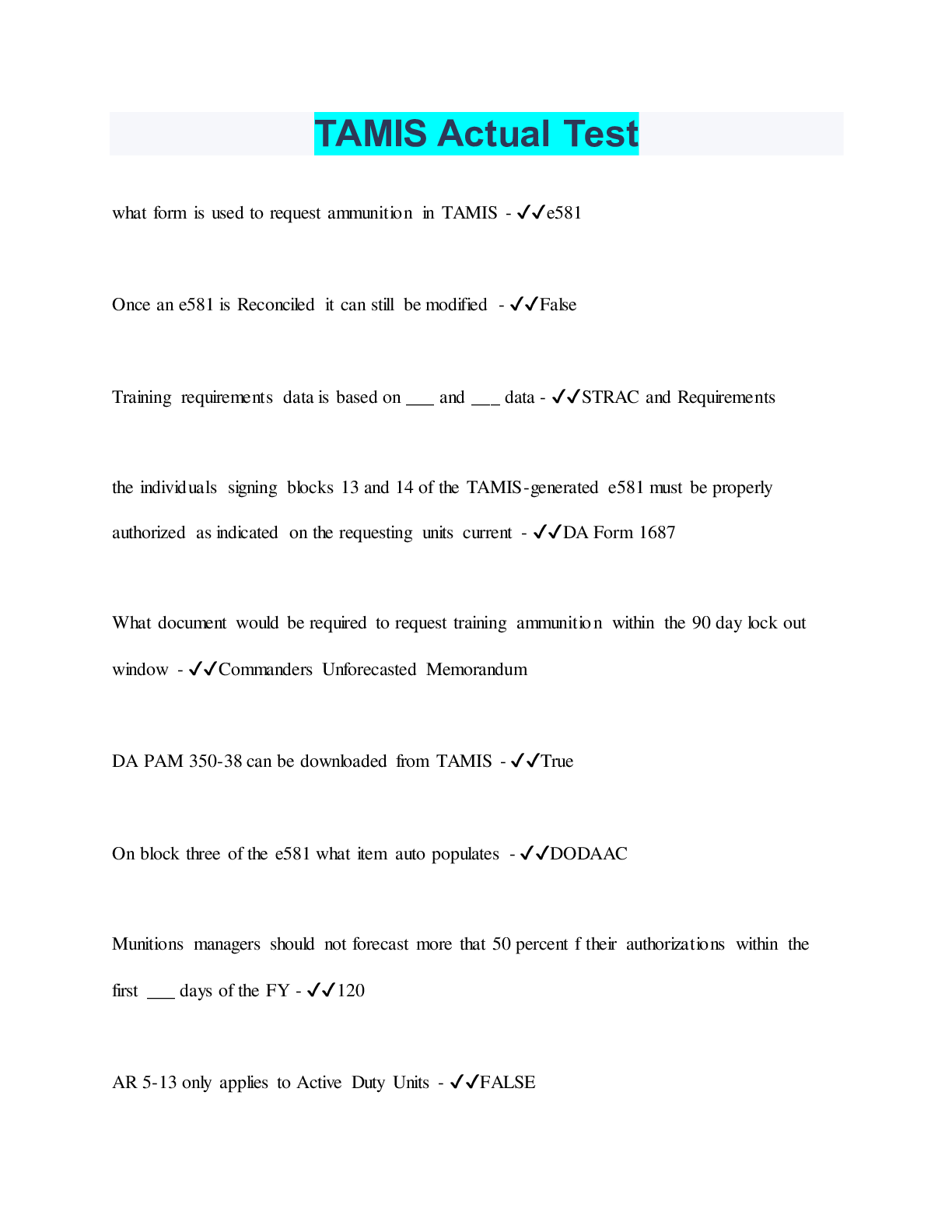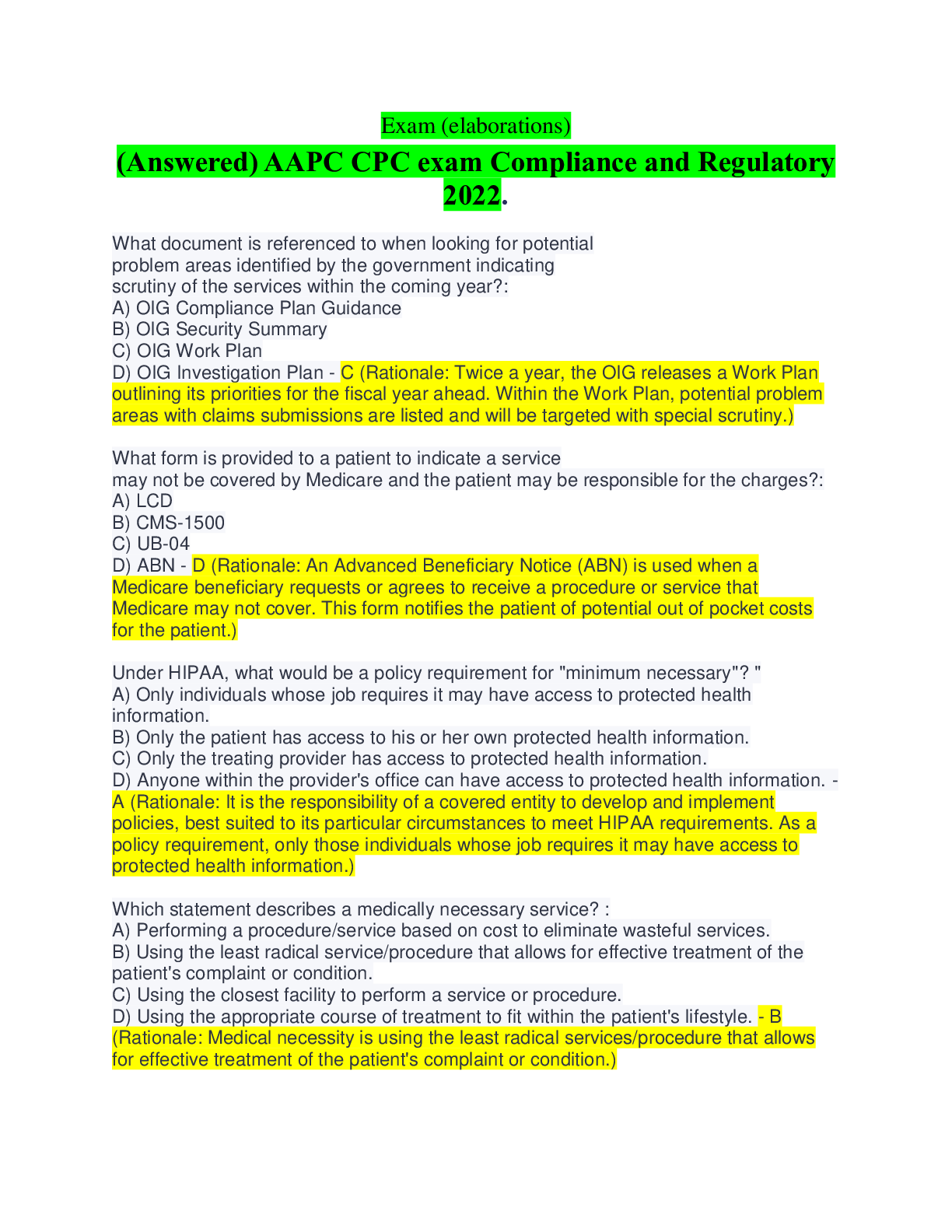Anatomy and Physiology - A&P 2 > EXAM > Straighterline AP2 202 Anatomy & Physiology 2 A&P 2 Midterm Grade 180.00 out of 180.00 (100%) (All)
Straighterline AP2 202 Anatomy & Physiology 2 A&P 2 Midterm Grade 180.00 out of 180.00 (100%)
Document Content and Description Below
Straighterline AP2 202 Anatomy & Physiology 2 A&P 2 Midterm Grade 180.00 out of 180.00 (100%) Question 1 Question text Hemocytoblast stem cells Select one: a. are specialized cells. b. are fo... und in yellow bone marrow. c. form branches of trees. d. are abundant in the plasma. e. give rise to all formed elements in the blood. Question 2 Question text Which plasma protein is correctly matched to its function? Select one: a. fibrinogen - transport of fatty acids b. albumin - helps to fight infection c. globulin - transport and immunity d. globulin - blood clotting Question 3 Question text The ability of white blood cells to leave the circulation and enter tissues is called Select one: a. chemotaxis. b. diapedesis. c. margination. d. intrusion. e. exocytosis. Question 4 Question text Healing after clot formation involves Select one: a. clot retraction. b. repair of the damaged blood vessel by connective tissue cells. c. clot dissolution. d. serum being squeezed out of the clot. e. All of these choices are correct. Question 5 Question text The hematocrit is Select one: a. an estimate of blood flow/hour. b. the number of WBCs per mm3. c. the amount of hemoglobin by weight in the blood. d. the percentage of RBCs in a given volume of blood. e. the number of RBCs in the body. Question 6 Question text Which of the following plasma proteins is most abundant? Select one: a. albumin b. globulins c. fibrinogen d. immunoglobulins e. hemoglobin Question 7 Question text All cardiac veins empty into the _________, which then empties into the _______. Select one: a. coronary sinus; left atrium b. coronary sinus; right atrium c. great cardiac vein; right atrium d. great cardiac vein; superior vena cava e. inferior vena cava; left atrium Question 8 Question text The period of time in which the myocardium is insensitive to further stimulation is called the Select one: a. absolute refractory period. b. hyperpolarization period. c. AV period. d. SA period. e. ectopic focus. Question 9 Question text The "pacemaker" of the heart is the Select one: a. right bundle branch. b. left bundle branch. c. AV node. d. SA node. e. PM node. Question 10 Question text Aortic stenosis results from Select one: a. a hole in the interatrial septum. b. a weakening of heart muscle. c. a narrowed opening through the aortic valve. d. low oxygen levels. e. leakage from the AV valves. Question 11 Question text Which of the following is administered to the people suffering from myocardial infarction following onset of symptoms? Select one: a. Beta-adrenergic blocking agents b. Nitroglycerine c. Tissue plasminogen activator (t-PA) d. Digitalis Question 12 Question text An incompetent pulmonary semilunar valve could result in less blood reaching the Select one: a. lungs. b. heart muscle. c. right ventricle. d. aorta. e. right atrium. Question 13 Question text Select the description below that describes pulmonary circulation. Select one: a. System of blood vessels that carries blood from the heart to the lungs and back to the right atrium of the heart. b. System of blood vessels that a carries blood from the heart to the rest of the body. c. Finely dissected blood vessels that allow for the exchange of nutrients in the tissues. d. System of blood vessels that carries blood from the heart to the lungs and back to the left atrium of the heart. of the heart. Question 14 Question text What is the most important means by which capillary exchange occurs? Select one: a. exocytosis b. diffusion c. ATP powered pumps d. facilitated diffusion Question 15 Question text The exchange of nutrients and gases between the blood and tissue cells is the primary function of Select one: a. veins. b. arteries. c. arterioles. d. capillaries. e. venules. Question 16 Question text From the heart to body tissues, which of the following sequences of vessels is correct? Select one: a. muscular artery, arteriole, elastic artery, capillary b. arteriole, muscular artery, elastic artery, capillary c. elastic artery, muscular artery, arteriole, capillary d. elastic artery, arteriole, muscular artery, capillary e. distributing artery, muscular artery, medium artery, capillary Question 17 Question text Case study: Dale Fremore was back home after spending the day at a picnic where he ate some "spoiled" potato salad. He developed severe abdominal pain and cramps, vomiting, and diarrhea. After about ten to twelve episodes of water diarrhea, Mr. Fremore became so pale and weak he could hardly walk. His wife took him to the hospital where he was diagnosed with severe dehydration (decreased plasma volume). Mr. Fremore was suffering from shock. The body has several mechanisms that can come into play to try to maintain blood pressure and blood flow when a person goes into shock. Urine output usually decreases when a person is in shock. This is the result of Select one: a. decreased ADH secretion. b. increased renin secretion. c. increased secretion of atrial natriuretic factor. d. decreased vasoconstriction due to the stress relaxation response. e. decreased aldosterone secretion Question 18 Question text Arteriosclerosis results in decreased compliance, which in turn causes the pulse pressure to Select one: a. increase. b. decrease. c. increase, then decrease. d. decrease, then increase. e. remain the same. Question 19 Question text How do lymphatic capillaries differ from blood capillaries? Select one: a. Lymphatic capillaries do not have a basement membrane. b. Simple squamous epithelial cells of lymphatics overlap with loose attachments. c. Lymphatic capillaries are more permeable than blood capillaries. d. Lymphatic capillary epithelium act as one-way valves preventing movement of fluid back into interstitial spaces. e. All of the choices are ways lymphatic capillaries differ from blood capillaries. Question 20 Question text The white pulp of the spleen Select one: a. contains lymphocytes that can stimulate an immune response. b. filters lymph as it flows through the spleen. c. destroys defective red blood cells. d. stimulates immune responses, filter lymph, and destroys defective red blood cells. Question 21 Question text The lymphatic system is involved in Select one: a. lipid absorption from the digestive tract. b. transporting lymph from the intestines to the liver. c. maintenance of pH in the tissues. d. production of erythrocytes. e. protein metabolism. Question 22 Question text Germinal centers are the sites of Select one: a. increased blood flow to the lymph nodes. b. fluid production. c. increased flow of lymph from infected tissues. d. entrance of lymph into lymph nodes. e. proliferation of lymphocytes in the lymph nodes. Question 23 Question text An opsonin is a __________________. Select one: a. subclass of immunoglobulin. b. compound released by leukocytes that aids in the immune response to an antigen. c. substance that promotes fever. d. compound released by leukocytes that inhibits the immune response to an antigen. e. substance that makes antigens more susceptible to phagocytosis. Question 24 Question text Which is the proper order of events in cell-mediated immunity? (1) cloning of cytotoxic T cells and memory T cells (2) antigen presented to T lymphocyte (3) activation of T lymphocytes (4) cytotoxic T cells attack target cells Select one: a. 2, 3, 4, 1 b. 1, 4, 2, 3 c. 2, 3, 1, 4 d. 3, 2, 4, 1 e. 1, 2, 3, 4, Question 25 Question text An abnormal, exaggerated response of the immune system is called Select one: a. immunization. b. an innate immune response. c. hypersensitivity. d. excess immunity. e. tolerance. Question 26 Question text Which of the following is part of the upper respiratory tract? Select one: a. lungs b. pharynx c. trachea d. bronchi e. bronchioles Question 27 Question text The nasal septum Select one: a. divides the nose into superior and inferior chambers. b. forms the floor of the nasal cavity. c. is the opening of the nose to the outside environment. d. is the part of the nose responsible for the sense of smell. e. divides the nose into right and left chambers. Question 28 Question text The chemosensitive area of the brain is located in the Select one: a. pons. b. cerebral peduncles. c. cerebellum. d. hypothalamus. e. medulla oblongata. Question 29 Question text The volume of air inspired or expired with each breath is the Select one: a. residual volume. b. inspiratory reserve volume. c. tidal volume. d. expiratory reserve volume. Question 30 Question text Ventilation refers to the Select one: a. movement of air into and out of the lungs. b. gas exchange between the blood and the tissues. c. transportation of oxygen and carbon dioxide in the blood. d. gas exchange between the air in the lungs and the blood. e. respiration at the cellular level. Question 31 Question text External respiration refers to Select one: a. atmospheric air coming into the lungs. b. gas exchange between the lungs and the blood. c. gas exchange in the atmosphere. d. gas exchange between the blood and body tissues. e. cellular respiration. Question 32 Question text In which of the following situations is compliance greatest? Select one: a. collapse of the alveoli b. airway obstruction c. emphysema d. pulmonary fibrosis e. pulmonary edema Question 33 Question text Which of the following results in an increase in shunted blood (blood not completely oxygenated)? Select one: a. exercise b. pulmonary edema c. increased heart rate d. increased respiration rate e. None of these choices is correct. Question 34 Question text Food in the stomach is squeezed and mixed with gastric juices, forming a semiliquid called Select one: a. bolusin. b. chyme. c. bile. d. phlegm. e. feces. Question 35 Question text The major secretion of the large intestine is Select one: a. bile. b. hormones. c. mucus. d. vitamins. e. bacteria. Question 36 Question text Bile would flow directly from the Select one: a. gallbladder into the hepatic duct. b. hepatic ducts into the common hepatic duct. c. bile canaliculus into the cystic duct. d. common bile duct into the gallbladder. e. cystic duct into the hepatic ducts. Question 37 Question text Which of the following is true? Select one: a. Peptidases are made in the large intestine. b. Intestinal epithelial cells absorb more dipeptides and tripeptides than single amino acids. c. The hepatic artery transports amino acids from the small intestine to the liver. d. Amino acids leave intestinal epithelial cells and enter the lacteals. e. Protein digestion starts in the duodenum. Question 38 Question text What moves the bolus during the esophageal phase of deglutition? Select one: a. pharyngeal constriction b. peristalsis c. the tongue d. segmentation Question 39 Question text The myenteric plexus is found in the _____ of the digestive tract wall. Select one: a. mucosa b. serosa c. submucosa d. muscularis e. adventitia Question 40 Question text Insulin increases the rate of _____ transport into cells. Select one: a. sucrose b. fructose c. glucose d. galactose e. lactose [Show More]
Last updated: 1 year ago
Preview 1 out of 17 pages

Reviews( 0 )
Document information
Connected school, study & course
About the document
Uploaded On
Aug 04, 2022
Number of pages
17
Written in
Additional information
This document has been written for:
Uploaded
Aug 04, 2022
Downloads
2
Views
168


